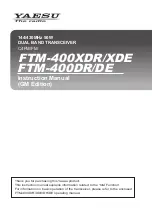
iGage iG9 User Manual
31
other surveyors and engineers
voice users (truckers, businesses, railroads, schools, service companies)
wireless microphones
SCADA equipment (like water or oil pipeline infrastructure)
control backhauls on com links
nearby AM or FM radio transmitters
nearby radar systems
The radio frequencies that are usually assigned (by the FCC in conjunction with frequency
coordination) are not exclusive and are assigned to multiple users in the same area.
By FCC rules, even unlicensed voice transmissions have a higher priority than licensed data
transmissions. Your radio (the radio built into your Base) will wait for other users before it transmits
(this is called CSMA: collision sense multiple avoidance.)
If you find that the frequency that you were going to transmit is busy, you can change the
channel/frequency of your Base and Rover to an alternate frequency. The radio frequency is set on
the Rover is under “Equip: GPS Rover: RTK (tab): Internal UHF Radio Settings”.
Base Output Power Setting
You probably will want the radio in your Base to output as high of power as possible. The setting for
the Base
output power is under “Equip: GPS Base: RTK (tab):
Internal UHF Radio Settings”.
If 2-watts with an elevated antenna is not sufficient, we recommend purchasing a high-power
repeater.
Bad Antennas
The UHF antennas on most GNSS equipment get beat around quite a bit. The antennas on the Base
and extension pole get whipped around in the wind a lot.
If you suspect that your antenna has gone bad, we recommend that you purchase two spare
antennas and change out both your Base and Rover. If the problem goes away, then you know that
one (or perhaps both) of your original antennas have failed.
We recommend that you not use ¼ wavelength antennas:
They require a ground plane at the Base of the antenna and have significantly (about 1/3) the range
of the ½ wavelength dipole antennas we supply. The ¼ wavelength antenna are not compatible with
the antenna extensions that we supply with a Base. iGage has both factory replacement and heavy-
duty super gain antennas available.
External Antenna Extension (Top of Pole Extension)
If you are having range issues, try removing the external antenna extension cable and mount the
Base antenna directly on the bottom of the Base receiver. We expect at least 1-mile open range
















































